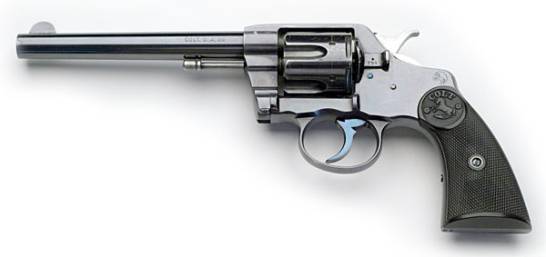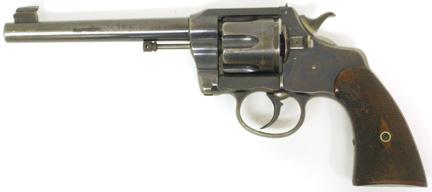COLT NEW ARMY AND NAVY

COLT NEW ARMY & NAVY COMMERCIAL MODEL
In 1889 Colt introduced the world's first double action, swing-out cylinder revolver. This design was so revolutionary that every double action revolver designed since used Colt's swing-out cylinder design.
The US Navy immediately bought the gun as the US Navy Model of 1889, and in 1892 the US Army also bought it in a slightly upgraded model as the US Army Model of 1892.
Colt also sold the gun as a commercial sales model, and it was immediately a popular gun with the public.
Colt put the new gun through a rapid series of design upgrades with each change getting a new model number.
These were the Models 1889, 1892, 1894, 1895, 1896, 1901 and the 1903.
Production stopped in 1907.
Serial numbers on the military and commercial models were stamped on the butt in two lines, with military models having US Army or US Navy stamps on the butt and military inspection stamps on the frame.
Other parts of the guns were stamped with factory assembly numbers. These numbers were stamped on parts during manufacture to keep fitted parts together until an actual serial number was assigned and stamped on the butt.
These assembly numbers are not serial numbers and had no further meaning once the serial number was stamped.
It's not unusual to see New Army & Navy revolvers with the serial number and military stamps removed from the bottom of the butt, and people assume the assembly numbers are the serial number, which they are not.
It's also common for owners to refuse to accept that the butt stamps were removed without leaving any signs of removal.
Because it was easy to remove stamps from the flat bottom of the frame, Colt began stamping double action revolvers serial number on the frame under the barrel where the cylinder crane seats, on the crane itself, and often inside the side plate.
Finish on the military models was blue with smooth walnut grips.
Barrel length was 6 inches, and the caliber was the .38 Long Colt.
The commercial models were available in blue and bright nickel with black, hard rubber grips with molded in checkering and Colt logo.
Barrel lengths offered were 3", 4 1/2", and 6".
Calibers were .38 Long Colt, .41 Long Colt, and very late in production in .32-20 and .38 Special.
These Colt's have extremely complex actions that get out of order or break easily. Due to a lack of usable parts and few gunsmiths willing to even attempt repairs, these guns should be treated very gently.
The New Army & Navy model is unique to Colt in that the cylinder rotates counter-clockwise, and the frame's side plate is on the right side. In later Colt revolvers the cylinder rotation is clockwise and the side plate is on the left side of the frame.
The Model 1889 originally had no locking notches on the outside of the cylinder, using the hand that advanced the cylinder to lock it in place during ignition.
This system was a major weakness in the design, since when the action was at rest, the cylinder was free to rotate. This could cause the cylinder to rotate so a fired cartridge was struck when the trigger was pulled instead of a live cartridge.
This was corrected by rebuilding almost all US Navy issue guns to use the same double cylinder locking notches on the outside of the cylinder that were used on the upgraded Model 1892.
Commercial Model 1889 revolvers were not recalled for the upgrade, so these guns are recognized by the lack of locking notches on the cylinder.
COLT MODEL 1889 US NAVY
Note the lack of locking notches on the outside of the cylinder and the side plate on the right side of the frame.

COLT NEW ARMY MILITARY MODEL
Note the double locking notches on the outside of the cylinder.

MILITARY SERVICE FAILURE
The New Army & Navy military revolver was official issue from 1889 to 1907 but the .38 Long Colt cartridge was not a very powerful round, being originally a black power round. Loading it with modern smokeless powder didn't improve it.
In the 1890's the US Army was fighting a guerilla war in the Philippines against radical Muslim Moro fighters.
These warriors would use drugs and religious fanaticism to put themselves into a berserker frenzy that allowed them to absorb bullets and continue to attack until loss of blood finally brought them down. Unfortunately, these failures to stop them with the low power .38 Long Colt allowed them to attack and kill US personnel even though they had sustained fatal wounds.
With cases of multiple soldiers empting New Army revolvers loaded with .38 Long Colt ammunition into rampaging Moros only to be hacked down, the Army realized they had to do something.
With the situation critical, the Army quickly removed obsolete Colt Single Action Army revolvers from storage in arsenals. These guns were refurbished, the barrels were shortened from 7 1/2" to 5 1/2" and rushed to the Philippines to replace the ineffective New Army in .38 Colt Long.
The reissued Single Actions in .45 Colt proved to be an effective solution to the problem, and along with issuing Winchester Model 1897 pump action 12 gauge shotguns the crisis was ended.
The Army realized that the .38 caliber was not an effective military cartridge so a search was started for a heavier caliber handgun to replace it was begun.
As a fill-in until a suitable gun could be developed, the Army bought standard Colt New Service double action revolvers in .45 Colt. This as adopted as the US Army Model 1909.
Ultimately the US government would adopt the Colt .45 Automatic, Model of 1911 as the new service pistol.
VARIATIONS
The Officer's Model, First Issue.
This was Colt's first medium frame double action Target revolver and the first of a series of Officer's Model target Colt's.
It was the New Army & Navy with a flat top frame and adjustable front and rear target sights.
The barrel was 6 inches and the gun was usually fitted with fancy checkered walnut grips and a high polish blued finish.
Calibers were the .38 Long Colt or .38 Special.
It was made from 1904 to 1908.
THE COLT OFFICER'S MODEL, FIRST ISSUE
